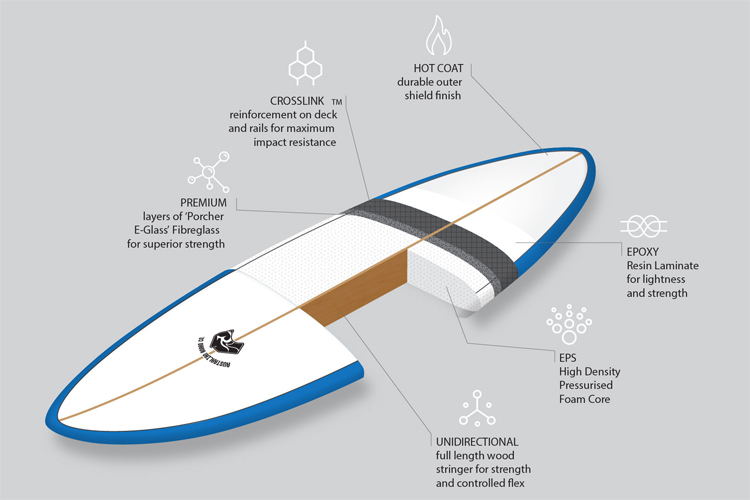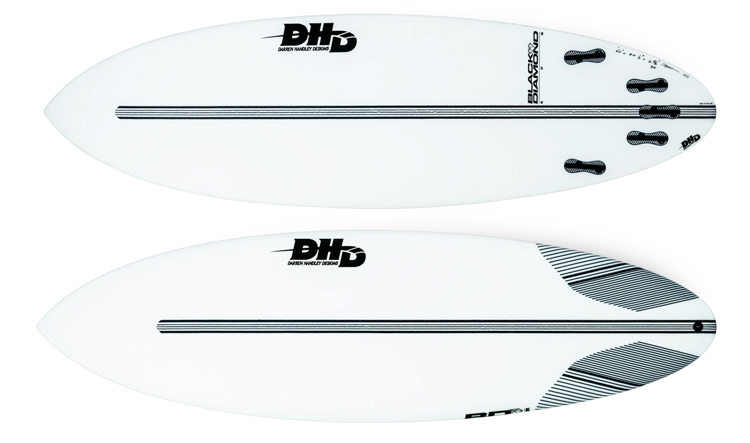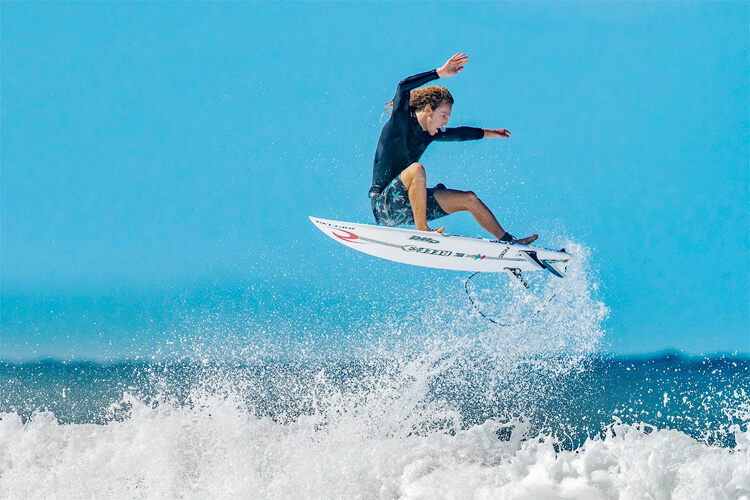What is an epoxy surfboard? It is better or worse than a fiberglass board? Why and when should you buy a polystyrene surfboard?
When it comes to construction and lamination, there are two types of surfboard manufacturing processes.
There's the traditional surfboard made from polyurethane (PU) foam with a coat of fiberglass and polyester resin.
And then there's the new generation surfboard made from polystyrene (PS/EPS) core blank with a coat of epoxy resin.
PU surfboards have been ruling the market for decades.
However, the development and recent popularity of EPS boards with epoxy resin added new variables to the buying decision process.
People often ask: Which one's better - polyurethane or epoxy surfboard? Which one should I buy?
A simplistic answer would be, "Both types of surfboards can be good, and it depends on what the surfer needs."
Generally speaking, and in most cases, epoxy surfboards are lighter, stronger, and faster.
Nevertheless, most surfers often prefer the feel and riding experience of standard polyurethane-fiberglass surfboards compared to polystyrene-epoxy boards.
PU boards are primarily hand-shaped, and any good surf shop sells plenty of models with subtle differences between them.
The good thing about a PU-fiberglass surfboard is that you can custom order it to your desired dimensions.
Surfers who have been riding PU boards for decades often say that an epoxy surfboard tends to travel faster or ahead of the surfer as if it's slipping forward under both feet.

From Niche to Alternative Surfboard
The so-called epoxy surfboards started gaining traction in the late 1990s before conquering a small but growing legion of fans.
The first models featuring EPS and epoxy components were stand-up paddleboards (SUP) and longboards before the early shortboards arrived.
Although EPS surfboards might not be the weapon of choice for ultra-steep and fast-breaking waves, they definitely perform well in mushier, small, or medium-size surf.
Do professional surfers use epoxy surfboards?
Yes. Pro surfers compete with expanded (EPS) or even extruded polystyrene (XTR/XPS) surfboards in certain wave conditions.
EPS is an open-cell foam.
For many years, consumers asked whether epoxy could match polyester/fiberglass for performance.
As time went by, surfboard manufacturers started exploring its potential, especially for the high-performance market.
This advanced foam alternative offers increased flex memory, high responsiveness, high buoyancy, and outstanding lightness.
But in the end, it will always be a matter of personal preference and/or wave conditions on offer.
Let's examine the advantages and disadvantages of epoxy surfboards when comparing two identical models with similar dimensions.
The Pros of Epoxy Surfboards
- Epoxy resin is up to 33 percent stronger than the standard resin used in polyurethane-fiberglass surfboards;
- An epoxy surfboard has more air in its core, so it floats better than a PU-based board;
- An EPS board is easier to paddle and will enter a wave faster than a standard fiberglass surfboard;
- The EPS/epoxy formula allows shapers to create boards with thinner rails while maintaining above-average flotation;
- A polystyrene foam-based surfboard is lighter than a traditional polyurethane foam-based surfboard;
- It's the perfect surfboard for beginner surfers;
- It's an excellent choice for taller and heavier surfers;
- It's a good option for mushy waves;
- It's the ideal surfboard for older surfers or surfers who are out of shape and still getting back to the waves after a long period off;
- When it comes to waterlogging, the epoxy surfboard's outer shell is more resistant to cracks and fissures. It is not indestructible, but it is pliable, tough, and handles dings better;
- It doesn't deform in the foot placement area like a PU board because the deck is dense and strong;
- An epoxy surfboard is easier to get through flat sections;
- In longboard models, it often feels cruisey;
- An epoxy surfboard is very durable compared to traditional fiberglass/polyester and is safer to travel with on a plane;
- Building an EPS surfboard uses fewer chemicals and is more environmentally friendly than a standard polyurethane board;
- An EPS blank can be combined with flax cloth and bio-resin;
- EPS can be recycled;
- An epoxy resin surfboard with a polystyrene core is the best choice for wave pools because freshwater is less buoyant than saltwater;
- An EPS board is great for aerial surfing;
- An XPS foam core nearly eliminates water absorption;

The Cons of Epoxy Surfboards
- An epoxy surfboard is generally more expensive than a fiberglass surfboard - between $100 and $150 more than a standard PU/fiberglass board;
- An EPS board offers more buoyancy, is harder to duck dive, and might be too light for some surfers;
- The process of building an epoxy surfboard involves more technology than human touch and is often mass-produced, so customization options are not always possible;
- Do you need a ding repair? If so, it might be harder to find someone who can fix your damaged epoxy surfboard;
- An EPS surfboard has less flex and memory than PU surfboards, resulting in a stiffer and rigid feel and making it more difficult to turn;
- Many epoxy boards are pressed into a mold in Asian countries and may not meet the minimum quality standards;
- An epoxy board tends to chatter more and bounce out in choppy or bumpy waves than standard PU boards;
- Epoxy resin takes twice as long to harden, so it takes more time to finish an EPS board compared to a traditional polyester/fiberglass board;
- An EPS surfboard doesn't cut through the water as well as a PU board because it is lighter and creates less momentum;
- An epoxy surfboard has less hold on the rails;
